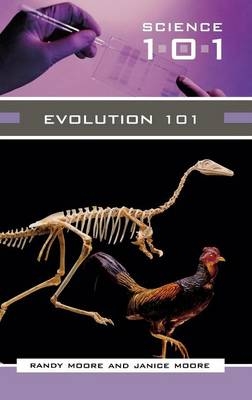
Evolution 101
Greenwood Press (Verlag)
978-0-313-33292-0 (ISBN)
What should the average person know about science? Because science is so central to life in the 21st century, science educators and other leaders of the scientific community believe that it is essential that everyone understand the basic concepts of the most vital and far-reaching disciplines. Evolution 101 does exactly that. This accessible volume provides readers - whether students new to the field or just interested members of the lay public - with the essential ideas of evolution using a minimum of jargon and mathematics. Concepts are introduced in a progressive order so that more complicated ideas build on simpler ones, and each is discussed in small, bite-sized segments so that they can be more easily understood.
Evolution 101 provides an introduction for non-scholars to this most powerful scientific theory, covering such issues as: the history of evolutionary thought, from before Darwin to the present day; the evidence for evolution, from fields as diverse as geology, molecular biology, paleontology, and more, that show how strongly supported evolution is; how evolution works, including topics ranging from behavior (e.g., sexual selection) to molecular biology (e.g., mutation); and evolution in our daily lives, including how evolution accounts for phenomena such as antibiotic resistance and pesticide resistance. This essential resource will answer the questions students and lay people have regarding evolution, and will point them on the path to further understanding.
Randy Moore is H.T. Morse-Alumni Distinguished Teaching Professor of Biology at the University of Minnesota. He had edited The American Biology Teacher and Journal of College Science Teaching, and serves on the editorial board of Journal of Biological Education. He has won numerous grants and teaching awards, including the Teacher Exemplar Award (Society for College Science Teachers). Moore, an Honorary Member of the National Association of Biology Teachers, has written over 200 articles and books, including numerous textbooks and Evolution in the Courtroom: A Reference Guide (2002). Janice Moore is professor of Biology at Colorado State University. She is the author of numerous scholarly articles and the book Parasites and the Behavior of Animals (2002). She is also co-editor of Host-Parasite Evolution (1997) and serves on the editorial board of BioScience.
Series Foreword
Preface
1 The History of Evolutionary Thought
Early Ideas About Life's Diversity
Naming Life
Lamarck Proposes the First Testable Theory of Evolution
Charles Darwin
Darwin Sets Sail Aboard the Beagle and Sees the World
Darwin's Life Back in England
Down House
Wallace Provokes Darwin to Announce His Idea
The Theory of Evolution After Darwin
Darwin's Bold Prediction
Summary
2 Evidence for Evolution
The Evidence for Evolution
The Age of the Earth
Determining the Ages of Fossils and Rocks
Fossils
Extinctions
Artificial Selection
Embryology
Biogeography
Comparative Anatomy
Vestigial Structures
Molecular Biology
We Can Watch Evolution Happen
Evolution, Life, and Death: The Evolution of Drug Resistance
Can Evolution Be Stopped?
Contradictory Evidence?
Evolution in the Courtroom
Summary
3 How Evolution Works
Genes Link Generations
Pesticide Resistance
DNA and Chromosomes
The Frequencies of Genes Can Change
What Causes Genetic Variation?
Mutation Can Cause Genetic Variation
Gene Flow Can Cause Genetic Variation
Genetic Mixing Can Cause Genetic Variation
Evolution Is Change in Gene Frequency—How Do Gene Frequencies Change?
Conservation and Genetic Diversity
Natural Selection Produces Adaptive Change in Gene Frequencies
Sexual Reproduction Increases Genetic Variation
The Red Queen and Sexual Reproduction
Mate Choice Can Be Adaptive
Selection for One Extreme, Both Extremes, or the Middle
Nice Guys Don't Have to Finish Last
Calculating Coefficients of Relatedness
Mutualism
Summary
4 The Scale and Products of Evolution
Microevolution Occurs Within Populations
Macroevolution Produces Species Diversity
What Is a Species?
How Do Species Form?
Species Form by Geographic Isolation, A Disturbance in Gene Flow
Species Form When Shifts in Resources Disturb Gene Flow
Species Form When Mate Choice Restricts Gene Flow
Species Form When Genetic Changes Disturb Gene Flow
The Common Theme of Speciation Is Reproductive Isolation
A Phylogeny Traces the History of Speciation
Shared Traits Reveal Shared Ancestry
Three Types (Branches) of Living Organisms
Where Did Life Come From?
The Evolution of Multicellular Organisms
Adaptive Radiation Fuels Biodiversity
Poisonous Oceans, Death Stars, and Mass Extinction
Summary
5 Evolution and Our Daily Lives
Darwin's Predictions Continue to Ring True
Social Darwinism
Eugenics
The Evolution of Pathogens
Sociobiology and Evolutionary Psychology
Human Evolution
Summary
Appendices
Appendix 1: The Geological Timescale
Appendix 2: Legal Decisions Involving the Teaching of Evolution and Creationism in Public Schools
Appendix 3: A Timeline for Evolutionary Thought
Appendix 4: Meiosis and Crossing Over
Appendix 5: The Products of Evolution
Glossary
Selected Bibliography
Index
| Erscheint lt. Verlag | 30.9.2006 |
|---|---|
| Sprache | englisch |
| Maße | 156 x 235 mm |
| Gewicht | 482 g |
| Themenwelt | Naturwissenschaften ► Biologie ► Evolution |
| ISBN-10 | 0-313-33292-4 / 0313332924 |
| ISBN-13 | 978-0-313-33292-0 / 9780313332920 |
| Zustand | Neuware |
| Haben Sie eine Frage zum Produkt? |
aus dem Bereich


